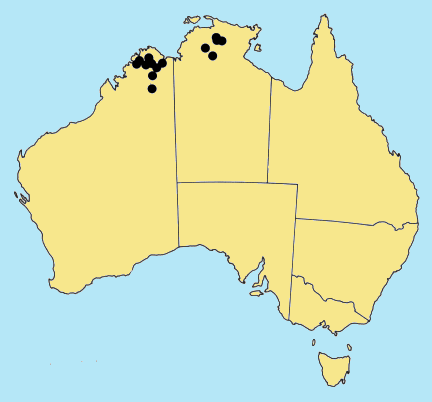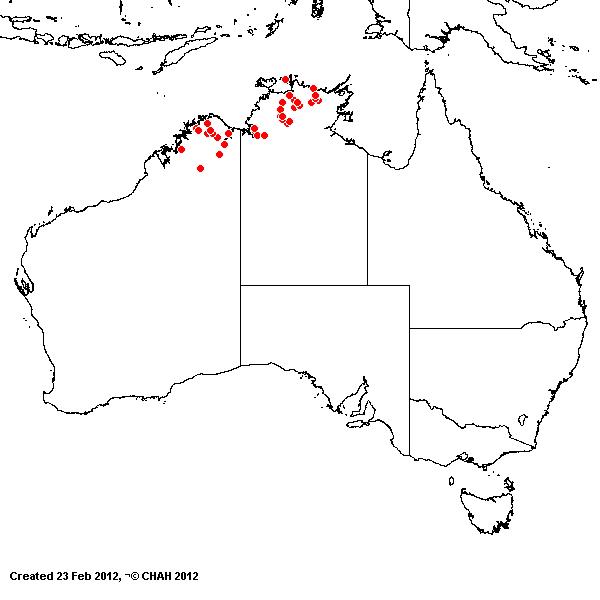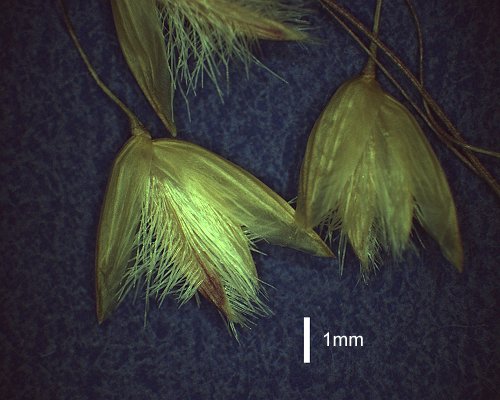Eriachne nodosa M. Lazarides. Austral.
Syst. Bot. 8: 400 (1995).
Classification. (GPWG 2001) : Subfamily
Micrairoideae. Eriachneae.
Type of Basionym or
Protologue Information: Australia, Darwin & Gulf district: Lazarides
6844 (CANB holo, BRI, DNA, K, MEL, NSW).
Key references
(books and floras): [2002] D.Sharp & B.K.Simon, AusGrass, Grasses of
Australia.
Illustrations:
[2005] K.Mallet (ed.), Flora of Australia 44B: Poaceae 3
(Fig28H-I).
Habit. Annual.
Culms erect or geniculately ascending, 32–62 cm tall, 3–6 -noded. Mid-culm
internodes glabrous. Mid-culm nodes glabrous. Lateral branches branched or
fastigiate. Ligule a fringe of hairs, 0.5–1 mm long. Leaf-blades flat or
involute, 1.4–8 cm long, 2–4 mm wide. Leaf-blade surface smooth or scabrous,
glabrous or indumented.
Inflorescence.
Inflorescence compound, a panicle or a panicle. Panicle ovate, 6–10.5 cm long,
6–8 cm wide.
Spikelets.
Spikelets pedicelled. Fertile spikelets 2-flowered, both fertile, comprising 2
fertile floret(s), without rachilla extension, ovate, laterally compressed,
4–5.3 mm long.
Glumes.
Glumes similar, thinner than fertile lemma. Lower glume ovate, membranous, much
thinner on margins, without keels, 5–7(–9) -nerved. Lower glume surface
glabrous or indumented. Upper glume ovate, 4–5 mm long, membranous, without
keels, 5 -nerved. Upper glume surface smooth, glabrous or indumented.
Florets.
Fertile lemma 4–5.3 mm long, without keel, 5 -nerved. Lemma surface indumented.
Lemma apex muticous. Palea 2 -nerved. Palea apex entire or dentate, muticous.
Lodicules present. Anthers 3. Grain 1.4–2.5 mm long.
Continental
Distribution: Australasia.
Australian
Distribution: Western Australia, Northern Territory.
Western Australia:
Gardner, Fitzgerald. Northern Territory: Darwin & Gulf.
Notes.
The most characteristic features of this species are the open panicles, often
almost as wide as long, with filiform often purple divisions bearing thickened
callus-like nodes and pulvini, which are bearded with long filiform hairs often
in whorls. Other useful characters are awnless spikelets, florets shorter than
glumes with appressed often purple lemma and palea, usually glabrous and smooth
glumes, grooveless lemmas with ciliate margins, entire muticous paleas,
relatively small shiny caryopsis almost as wide as long, and fastigiately
branched culms with glabrous nodes. In morphology, the spikelet resembles those
of E. obtusa and E. major, but E. nodosa differs by its
annual habit and other characters.
Endemic.
N.T. and W.A. N of 18ºS. Sandstone plateaux, undulating volcanic country,
basalt outcrops and lateritic flats, and usually sandy, moist or seasonally wet
sites in or near streams, in depressions and sometimes on disturbed ground.
Flowers and fruits chiefly in Mar. and May (autumn), but extending from
Feb.-Sept. (late-summer to early-spring).




